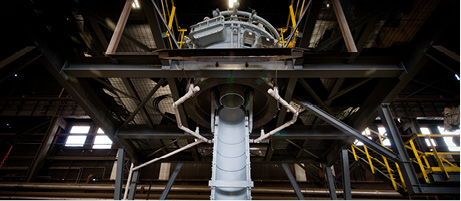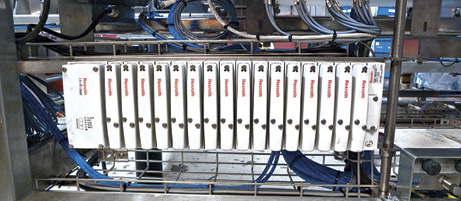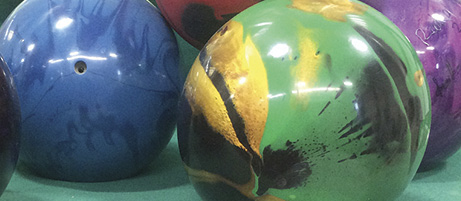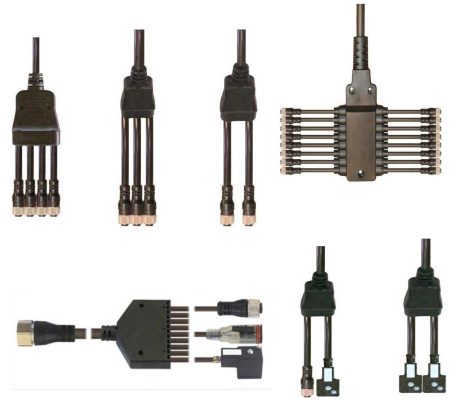Considerations for Using Sensors to Control Cylinders
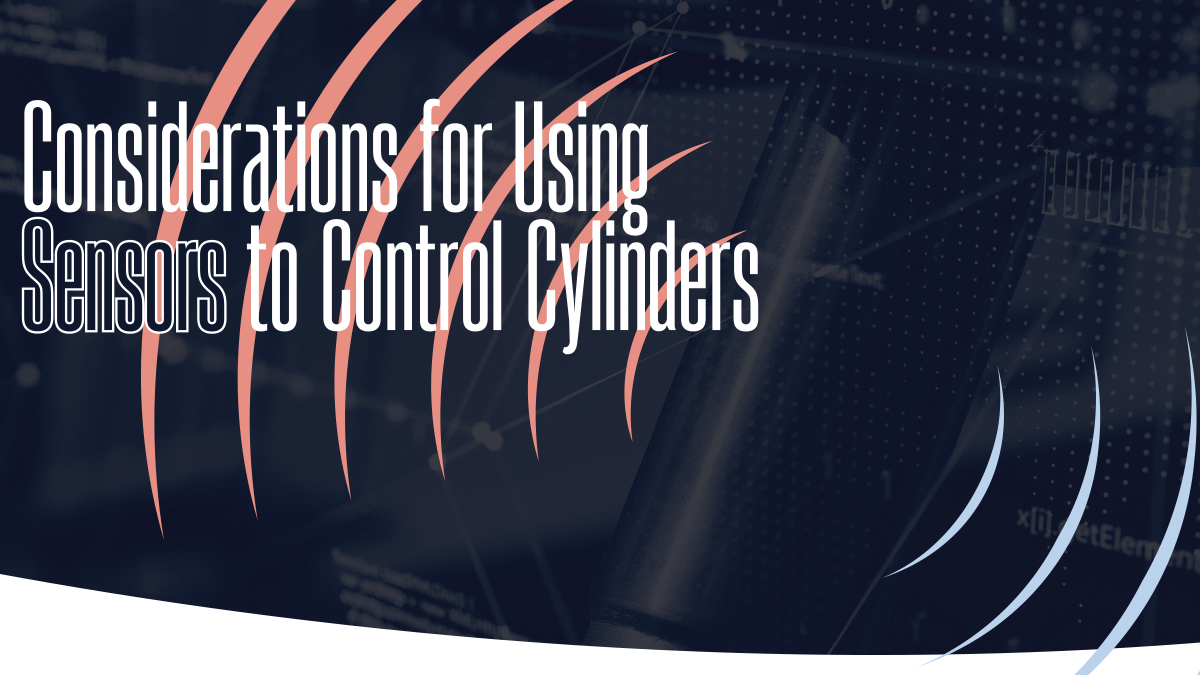
By Perry Hudson, Market Manager, Pepperl+Fuchs Inc.
The use of magnetic or inductive sensing devices to indicate cylinder position is nothing new. These proven methods each have their strengths, which we will discuss in this article. There are several factors to consider including environmental conditions, potential for interference, and cylinder integrity.
When examining which technology to use for cylinder position monitoring, a typical starting point is what the cylinder manufacturer already offers as a mounting port for a sensor and what is installed as a potential sensing target. It is common practice to have a dissimilar metal target on the inside of the shaft. This can provide a target for either a magnetic or inductive approach. In some cases, manufacturers even install a magnetic target on the shaft inside the housing, this is however an older approach. Regardless of whether it is a dissimilar metal or magnet; you can use the sensors in different mounting methods.
Magnetic sensors locate the target through the cylinder housing; therefore, they are typically strapped to the outer housing. This makes them popular because they are easier to install. A possible shortcoming of this approach may be that they are not as accurate in determining position as a sensor that is built into the housing. Another potential problem with magnetic sensors is that they can magnetize the housing they are attached to over time. This can lead to a position deviation, which can increase with temperature variations. However, these are only possibilities, as this technology is tried and tested and has been in use for over forty years.
Inductive sensors are installed in the cylinder at the end of travel. Most cylinder manufacturers pre-drill sensor ports today, so it is simply a case of understanding the required process dimensions. This approach has also proven to be very effective and accurate. Possible disadvantages of using inductive sensors can be that there are no current mounting ports. Drilling holes in cylinders can cause major problems, affect the warranty, and incur additional costs. There may also be problems with the required installation location of the sensor or the operating pressures. All of these concerns need to be considered, but again, this technology is proven and has been used for over forty years.
A third method is less invasive; the use of linear potentiometers or linear variable differential transformers (LVDTs). These are precise, proven, and sometimes the most inexpensive approach. These linear potentiometers are made up of cylinders with transducer rods having the same travel as the cylinders being monitored. They are mounted on the outside of the cylinder. The transducer rod is attached to the cylinder rod, tracking its movement. These devices monitor the position of the cylinder rods by measuring the change in resistance as the transducer rods change position. They are very effective, but also susceptible to damage to the exposed transducer rod. They are the oldest of the sensor technologies and have been used in the paper and textile industries for over eighty years.
The latest method is also non-invasive. It combines the precision and repeatability of an inductive sensor with the simple mounting of an LVDT. Linear inductive sensors came onto the market around twenty-five years ago. Unlike the aforementioned devices, only a target is mounted to the cylinder rod. The linear sensor is mounted next to the cylinder near the target. As the cylinder shaft travels over a row of sensor coils, it provides position feedback. As a rule, it can also provide end of travel or preset positions. Although this may not be the solution for everyone, this approach is becoming increasingly popular.
Once the sensing method has been selected, a decision must be made as to what type of control system is desired. While programmable logic controllers (PLCs) are the most common in industrial control, microcontrollers (MCUs) or dedicated process controllers are not uncommon in fluid control. Each of these devices can process sensor data and make decisions based on predefined logic. To choose the right sensing method, you need to know what is required in terms of discrete or analog inputs.
You now have determined the preferred type of position sensing and the type of signal processing that will be used to monitor and control the system. From here, a general understanding of the available sensor outputs will help finalize the application design. For a magnetic sensor, a mechanical Reed switch or dry contact is typically used. The two-wire circuit is energized, and when the magnet is applied, it closes the contact, creating a complete circuit.
An inductive sensor is a solid-state device that provides a discrete transistor output. This can be in the form of a voltage/current change for a two-wire sensor or a separate output signal for a three-wire sensor. Discrete two-wire sensors are older in design and have a simpler wiring scheme, but they have a constant voltage and leakage current flowing through them. While a single sensor in a no-load state will not generate enough leakage to send a false input to a typical modern processor, care should be taken to avoid connecting several of these sensors in series as leakage levels can multiply. For inductive three-wire sensors, this problem is avoided by the addition of a third output wire.
Another consideration with inductive sensors is the fact that their processing circuits are built with bipolar junction transistors for amplification and switching. These transistors come in two main types: NPN (negative-positive-negative) and PNP (positive-negative-positive). When choosing the right sensor for your control system, it is important to understand the differences in the application. A good way to understand is to look at the current flows for both. In an NPN transistor, most of the charge carriers are electrons, with current flowing to the positive side. In a PNP transistor, most of the charge carriers are positive and current flows to the negative side. Your control system will indicate which type of signal it requires as an input, so always confirm this.
We have now looked at sensing methods and outputs. We should discuss the typical control logic of a standard cylinder circuit. In most cases, sensors are used to indicate the end-of-stroke operation of the cylinder. This tells the system and the operator whether the cylinder is fully extended or fully retracted. In some systems, an analog signal is used to indicate a variable extended position, but the basic method of operation remains the same. The process begins with a start signal provided by either a sensing point, a manual switch, or even a PLC signal. Once the signal is received at the control device, either a PLC or a dedicated controller, a sequence of operations begins. These operations activate a directional control valve that controls the direction of air or liquid. The control valve determines whether the cylinder extends or retracts.
In response to this start signal, the control element sends a signal to the directional control valve of the cylinder, causing the cylinder rod to move to the desired position. As soon as the cylinder rod is in motion, the sensors detect the position of the rod and give the control element feedback about the full extension or retraction. This “feedback loop” determines the exact positioning of the control element and enables decisions to be made as to whether it should continue, stop, or change direction. The control element then acknowledges the end of the cycle and generates a stop signal.
This typical control circuit offers the option of adding safety features such as emergency stops into the circuit. Now reset circuits and redundant circuits may be added based on the functional safety requirements of the application. Through the use of visual indicators, such as lighting or an HMI, system maintenance and training can be integrated. The use of “intelligent sensors”, provides information that is useful for predictive maintenance.
Such a well-tested control design is far from obsolete. New advances in sensor and control technology enable reliable, precise control of cylinders with many mounting options. It all starts with the question: What do you want to do?


